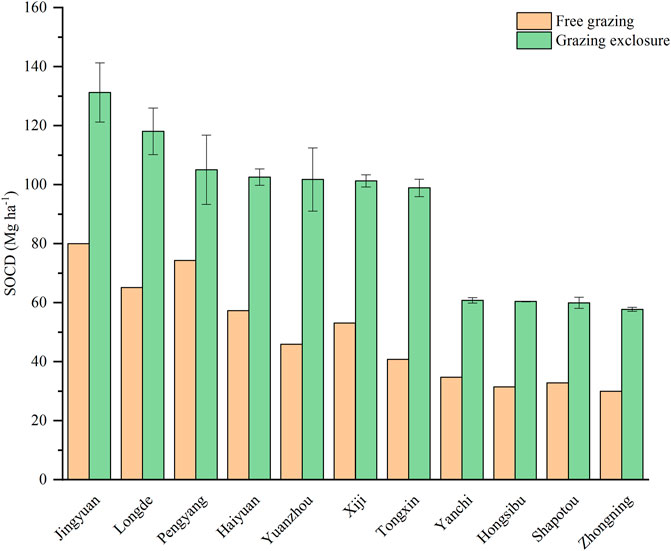- 1School of Agriculture, Ningxia University, Yinchuan, China
- 2School of Geography and Planning, Ningxia University, Yinchuan, China
- 3Institute of Desertification Control, Ningxia Academy of Agricultural and Forestry Sciences, Yinchuan, China
The temperate steppe experienced degradation and desertification as a result of long-term heavy grazing and excessive reclamation. Some major ecological projects, such as the Grain for Green Program (GGP) and Grazing Exclosure (GE), have been implemented to promote ecological restoration in grassland ecosystems. With the goal of carbon neutrality, the effects of the GGP and GE on grassland carbon sequestration need to be further explored. Based on soil data from the second soil survey in the 1980s, a field survey in 2021, and the land-use/land-cover datasets of 2000–2018, we characterized the changes in soil C stock following grazing exclosure, analyzed the effect of GGP on land-use changes and soil C accumulation, and then estimated the overall grassland carbon sequestration in Ningxia on the Loess Plateau of China. From 2000 to 2018, GE increased the grassland SOCD from 49.60 Mg ha−1 to 90.71 Mg ha−1, and the C stock increased by 65.55 T g. Under the influence of the GGP, 347.62 km2 of cultivated land was converted into grasslands, increasing the grassland soil carbon sequestration by 1.31 T g. Subsequently, the grassland organic carbon storage increased by 66.86 T g, which accounted for approximately 4.26% of the grassland organic carbon storage in the Loess Plateau of China. In the southern Loess hilly area, which experienced high precipitation and low temperatures, grasslands increased by 95.55 km2; the average organic carbon density increased 46.95 Mg ha−1 due to a rate of increase of 2.61 Mg ha−1 yr−1; and the corresponding values for those in the middle arid zone were 36.25 Mg ha−1 and 2.01 Mg ha−1 yr−1, with grasslands decreasing by 147.41 km2. The follow-up policies of the GGP and GE should be implemented and improved according to local conditions to improve the carbon sink and ecological services in grassland ecosystems.
Introduction
Grasslands, which cover approximately 30% of the land surface of the world, play an important role in the global biogeochemical cycle and energy exchange (Conant et al., 2001; Hu et al., 2016; Li et al., 2019). Soil organic carbon (SOC) is the largest terrestrial organic carbon pool in the terrestrial biosphere (Scharlemann et al., 2014). Grasslands store 10%–30% of the SOC globally and have been reported to sequester carbon in the soil at a rate of 0.5 Pg yr−1, which accounts for approximately a quarter of the potential C sequestration in soils globally (Follett and Reed, 2010; Qiu et al., 2013). In China, grasslands are widely distributed, covering an area of approximately 4.0 × 107 km2, and account for approximately 41% of China’s total land area (Wang et al., 2019). The total amount of SOC stored in the grasslands in China is 24.03 ± 2.52 Pg, accounting for 37% of the total SOC in China (Tang et al., 2018). For decades, dry climate and fragile ecological conditions, along with long-term heavy grazing and excessive reclamation, have led to severe grassland degradation and desertification, subsequently affecting the sustainable development of China (Ding, 2003).
The re-vegetation of degraded lands is one of the main global strategies for soil erosion control and ecosystem restoration (Deng et al., 2014a). The Grain for Green Program (GGP) (also called the Sloping Land Conversion Program), which was initiated in 1999, is one of the largest ecological restoration projects undertaken by the Chinese government (Wang et al., 2007; Liu et al., 2008). The project aims to reduce soil erosion and increase vegetation cover to improve the ecological conditions in the Loess Plateau; the process includes the restoration of cultivated land to forestland and grassland, unused land afforestation, grass planting (Song et al., 2014), and ecological conservation (planting trees/grass and protecting them from human activities to prohibit destruction) (State Forestry Administration, 2013). The GPP has promoted the conversion of degraded lands (Fu et al., 2011; Deng et al., 2012) and has significantly increased carbon sequestration in China (Persson et al., 2013; Deng et al., 2017a). The Grazing Exclosure Policy (also called the Returning Grazing Land to Grassland Project) is another important ecological protection measure following the GGP. It is widely regarded as one of the strategies to restore overgrazed grassland vegetation and promote ecosystem C storage through self-healing (Hu et al., 2016). Most studies have shown that plant C storage can be promoted after removing grazing pressure due to the increase in plant productivity and litter accumulation (Wang et al., 2014; Smith et al., 2015). Moreover, many studies have reported that the increase in the quantity of organic matter input has led to an increase in soil carbon content after grazing exclosure (Pei et al., 2008). The natural grassland area in northwest China accounts for 74.8% of the national natural grassland area (Sun, 2003), which is an important ecological safety barrier and livestock production base. Research on grassland SOC in northwest China mainly focuses on the Qinghai–Tibet Plateau, Inner Mongolia, Xinjiang, Shaanxi, and Gansu Provinces (Wang et al., 2010; Tian et al., 2016; Zhu et al., 2016; Luo et al., 2019; Dai et al., 2021; Tai et al., 2021; Li et al., 2021), with studies of the Ningxia grassland mainly focusing on the community and watershed scales (Wang et al., 2016; Chai et al., 2019).
As an important part of the northwest pastoral area, the Grain for Green Program was implemented from 2000 onward, and the Grazing Exclosure of grasslands was implemented from 2003 in the middle and southern parts of Ningxia. Due to its unique climate and vegetation, together with its widespread grasslands across the region, the grasslands in Ningxia on the Loess Plateau are an ideal region for investigating the effects of the Grain for Green Program and Grazing Exclosure on soil carbon change in steppe ecosystems. It remains unclear how grassland SOC changes after the GGP and GE at the regional scale.
In this article, we analyzed the data from the Second National Soil Census and field sampling in Ningxia on the Loess Plateau of China and then evaluated the grassland carbon stock during the ecological recovery process of grasslands following the Grain for Green Program and Grazing Exclosure in a transitional zone from semi-humid areas and semi-arid areas to steppe ecosystems in arid areas. Specifically, we aimed to explore the following two questions: 1) how do land-use pattern changes affect the grassland carbon pool after the Grain for Green Program? 2) How does soil organic carbon density and carbon sequestration change following grazing exclosure? We hypothesized that 1) GGP implementation would lead to a major change in land use, which could have a profound impact on the soil organic carbon content and distribution, and 2) Grazing Exclosure would increase the soil C stock because of the increase in the quantity of organic matter input after the removal of grazing pressure.
Materials and Methods
Study Area
The study area is on the northwest edge of the Chinese Loess Plateau, located in the middle and southern parts of the Ningxia Hui Autonomous Region (35°14′-39°23′, N104°17′-107°39′ E), including 11 counties (Figure 1). The study area has a temperate steppe climate zone, and grasslands are one of the main vegetation types. Typical steppes are distributed over the southern Loess hilly area (mainly including Yuanzhou District, Pengyang, Xiji, Jingyuan, and Longde), where the main vegetation types are Stipa bungeana, Artemisia gmelinii, and Stipa grandis. Desert steppe areas are mainly in the middle arid zone (including Haiyuan, Hongsibu, Shapotou, Zhongning, Yanchi, and Tongxin), dominated by Stipa breviflora and Salsola passerina Bunge.
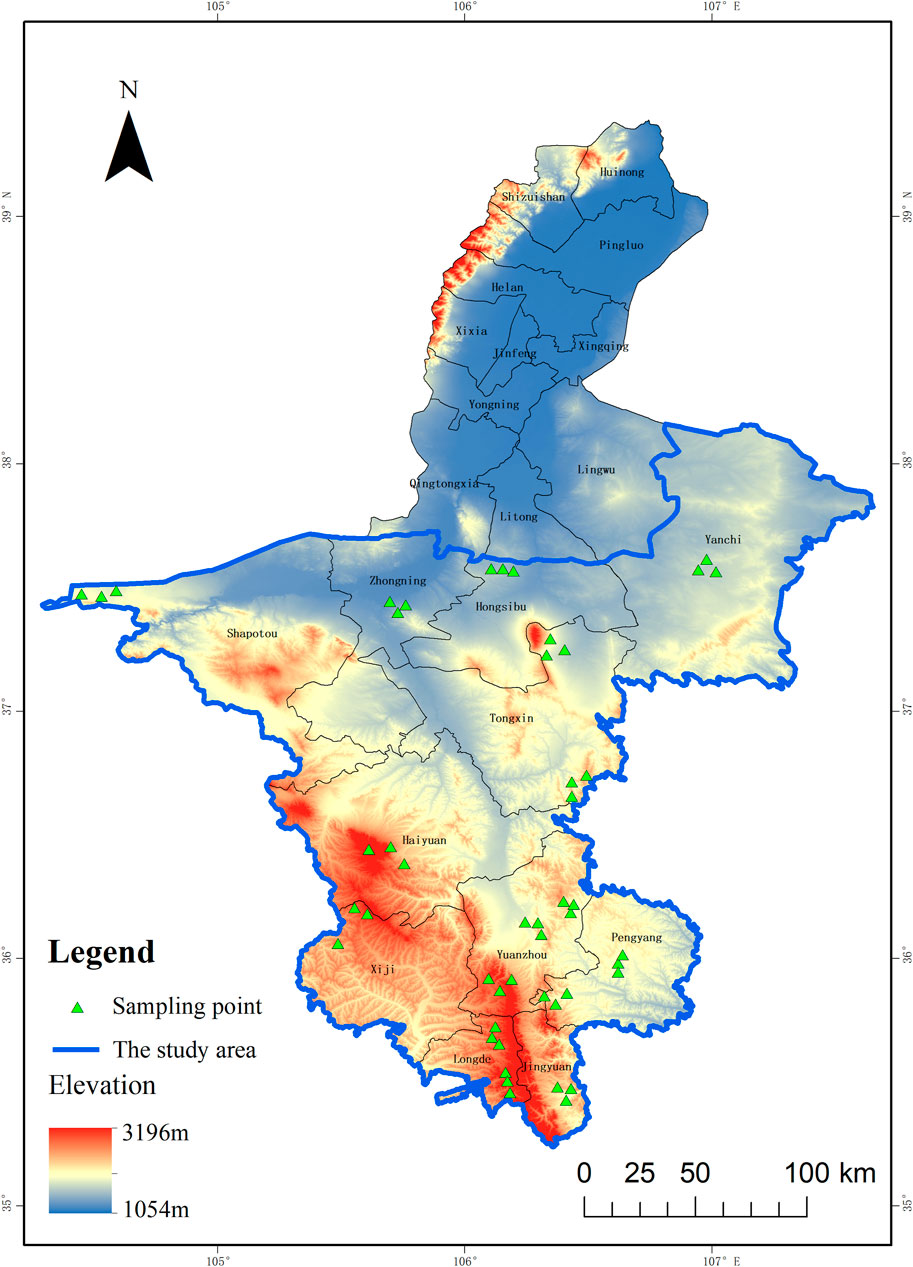
FIGURE 1. Administrative region of Ningxia and the distribution of sampling points in the study area.
Data Sources
In July–August 2021, we sampled soils at 48 sites with grazing exclosures in 11 counties of Ningxia Province. At each site, three 20 m × 20 m sampling subplots were located along a random sampling transect at 20-m intervals, and the soil was sampled to a depth of 100 cm. Within each subplot, five soil cores were collected at fixed-depth intervals of 0–10, 10–20, 20–40, 40–60, and 60–100 cm using a 7-cm-diameter corer in the center and four corners of each subplot, and the five cores from each interval were then combined. After each soil sample was air-dried and sieved through a 2-mm mesh, the organic carbon content (SOC) was determined using the Walkley–Black wet oxidation method. Samples for estimating bulk density were collected for each interval using stainless steel cutting rings with a volume of 100 cm3 and then dried at 105°C to constant weight, and the soil bulk density was calculated as the soil dry mass divided by the volume.
The land-use data from 1990, 2000, and 2018 were obtained from the Resource and Environmental Science and Data Center of the Institute of Geographical Sciences and Natural Resources Research, Chinese Academy of Sciences (http://www.resdc.cn/), with a spatial resolution of 30 m. According to the Land Use/Cover Standard of the Chinese Academy of Sciences (Zhang et al., 2011), land-use types are classified into cultivated land, forestland, grassland, water, built-up land, and unused land with reference to the actual situation of the study area.
The SOC data of grasslands and sloping farmlands before the GGP and GE were chiefly obtained from the data collation of the Second National Soil Census “Ningxia Soil Species” and “Ningxia Soil.” Since the data do not include soil bulk density, the corresponding data were obtained from relevant literature (Su, 2006; Hua et al., 2009; Yu et al., 2019a). The grassland dataset includes 35 typical profile points, and the cultivated land dataset includes 27 typical profile points. Meteorological data were obtained from the China Meteorological Data Network (http://data.cma.cn/) and the Ningxia Meteorological Bureau. The population data were extracted from the Ningxia Statistical Yearbook (2001–2021).
Methods
The SOC density was calculated for the 0–100 cm depth using the following recommended equation (FAO, 2017; FAO, 2019):
where
The formula used for calculating the C stocks is as follows:
where
The land-use changes are operated in ArcGIS 10.2 (ESRI Inc. California, United States). The data were calculated and analyzed using the SPSS software program, ver. 22.0 (SPSS Inc. Chicago, United States), and the column chart and linear fit were performed with Origin 2021b (OriginLab, Corp. Northampton, MA, United States).
Results
Effects of GE on the Grassland Organic Carbon Pool
The implementation of GE increased the grassland SOCD, which was higher than that in the free-grazing grasslands (Figure 2). Before the grazing exclosure, the variation range of grassland SOCD was 30.00–79.99 Mg ha−1. After GE, the SOCD varied from 57.73 to 131.26 Mg ha−1 among counties. In terms of regional distribution, grassland SOC densities in the Jingyuan, Longde, and Pengyang regions around the Liupan Mountains were higher than those in other regions, and grassland SOCD gradually decreased from the Liupan Mountains in the south to the middle arid zone. Due to the long-term extensive cultivation in the historical period, the organic carbon densities of the sloping farmland were relatively low, with a variation range of 32.03–73.73 Mg ha−1.
The range of increase in grassland SOCD caused by long-term GE was 24.90–58.16 Mg ha−1, with an average value of 44.11 Mg ha−1 (Table 1). From 2000 to 2018, the grassland area was maintained at 1.72 × 104 km2 (Figure 3 and Table 1), and the grassland carbon storage increased by 65.55 T g through GE. Haiyuan County and Tongxin County had larger carbon sequestration than other counties due to the large area of GE and greater increase in grassland SOCD. Although Yanchi and Shapotou had a large grassland area, the increase in SOCD was less, resulting in a small SOC stock. Longde and Jingyuan, located near the Liupan Mountains, reported a large increase in the SOCD; however, due to the large proportions of forestland and the small grassland areas, the total carbon storage of the grasslands was lesser.
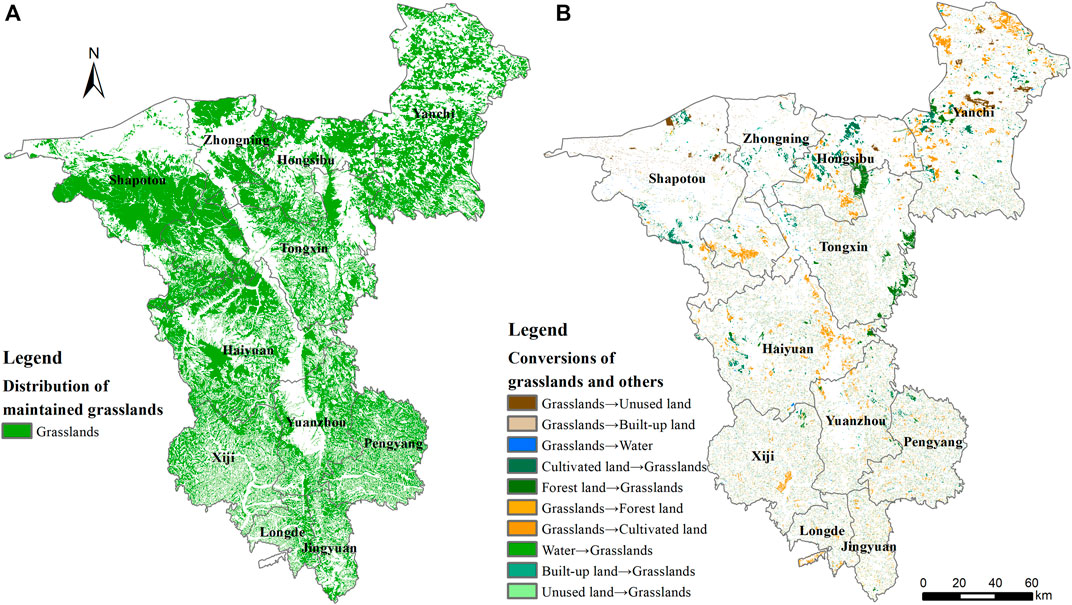
FIGURE 3. Distribution of the grasslands maintained and their conversion with other land-use types from 2000 to 2018.
Effects of Land-Use Changes Induced by the GGP on Grassland Organic Carbon Pools
Grasslands and cultivated land were the main land-use types in the study area (Figure 4). The grassland area was the largest, with an average of 1.87 × 104 km2, followed by the cultivated land area, which accounted for 49.88% and 35.47% of the total land area, respectively. From 2000 to 2018, the grasslands, cultivated land, and unused land areas decreased, while the built-up land, forestland, and water areas increased. The change trends of the southern and middle arid zones were different. In the southern Loess hilly area, the grassland and forestland areas increased by 95.55 and 30.56 km2, respectively, while the cultivated land area decreased by 222.12 km2. In contrast, the middle arid zone observed a stark increase (414.33 km2) in the forestland area, while the grassland and cultivated land areas decreased by 147.41 and 697.50 km2, respectively.
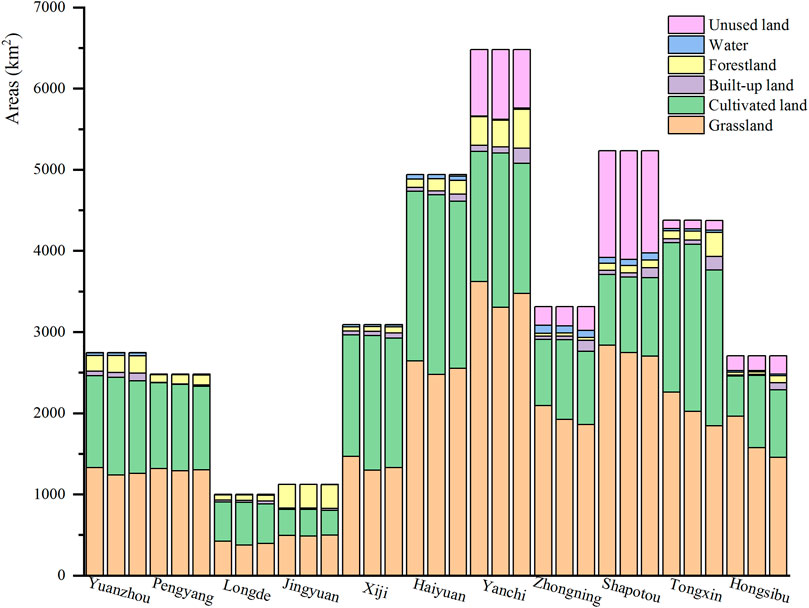
FIGURE 4. Stacked column chart showing the area of land-use types in 1990, 2000, and 2008 from left to right.
According to the land-use transition matrix between grasslands and other land types (Table 2), in the southern Loess hilly area, 95.55 km2 of cultivated land was completely converted to grasslands. In the middle arid zone, 216.03 and 107.89 km2 of cultivated land were converted to grasslands in Yanchi and Haiyuan, respectively, but the grassland area decreased by 399.48 km2 in Zhongning, Hongsibu, Shapotou, and Tongxin. In fact, in the 1990s, before the GGP was implemented, the occupation and degradation rates of grasslands were even more alarming. From 1990 to 2000, the grassland area decreased by 1,379.00 km2 (Figure 4), accounting for 9% of the grassland area of the middle arid zone. Therefore, in the middle arid zone, the GGP is an effective measure to avoid excessive, rapid, and large-scale occupation of grasslands.
By 2018, a total of 347.62 km2 of cultivated land had been converted to grasslands in the Pengyang, Guyuan, Xiji, Jingyuan, Longde, Haiyuan, and Yanchi counties, which has led to an increase of 1.31 T g carbon sequestration in the grasslands in Tongxin, Shapotou, Zhongning, and Hongsibu. Due to drought and population pressure, grassland degradation was severe. From 2000 to 2018, the grassland area decreased by 399.48 km2, and the cumulative loss of potential carbon storage was 1.41. The decrease in grasslands in some areas objectively reduced the ecological effect of the GGP, resulting in a loss in SOC.
Discussion
The Effect of Grazing Exclosure on Soil C Stock
Overall, large-scale grazing exclosure significantly increased the grassland carbon stock in the temperate steppe (Figure 2), indicating that GE is an effective measure to restore grassland ecosystems. Our results are consistent with those of other studies on grasslands on global (Conant et al., 2001) and regional scales (Hu et al., 2016; Xiong et al., 2016). The implementation of GE increased grassland SOCD from 49.60 Mg ha−1 to 90.71 Mg ha−1, which was higher than the average SOCD of Chinese grasslands (84.6 Mg ha−1) (Xu et al., 2018). According to Zhang et al. (2016), the average carbon storage of the grasslands in China’s Loess Plateau was 1.57 Pg C. The grassland organic carbon storage in the study area increased by 65.55 T g after GE, which accounted for approximately 4.17% of the grassland organic carbon storage in the Loess Plateau.
In different regions, the accumulation rate of SOC may vary considerably with climate, soil, and human management (Wang et al., 2017; Chang et al., 2011). The accumulation rate of grassland organic carbon in the southern Loess hilly area was higher than that in the middle arid zone after GE. The average SOCD increased by 46.95 Mg ha−1 in the southern Loess hilly area after GE, with an increased rate of 2.61 Mg ha−1 yr−1; the values for the middle arid zone were 36.25 Mg ha−1 and 2.01 Mg ha−1 yr−1. Deng, (2017b) estimated a mean rate of soil C stock change of 1.30 Mg ha−1 yr−1 at 0–100 cm soil depths in China’s grasslands, and Qiu et al. (2013) reported an accumulation of 1.68–4.40 Mg ha−1 yr−1 at 0–80 cm soil depths in GE grasslands compared to grazing grasslands on the Loess Plateau, China. Therefore, the increasing rate of grassland organic carbon accumulation in the study area was greater than that in China and at the intermediate level of the Loess Plateau of China. There are three possible reasons for the high rate of soil sequestration in the southern Loess hilly area. First, low temperatures in the southern region could restrain microbial activity and reduce the decomposition of SOM, which would contribute to C accumulation in the soil (Schimel et al., 1994). Second, precipitation and humidity are relatively higher in the southern Loess hilly area than in the middle arid zone (Figures 5, 6), which may enhance the soil carbon stock after grazing exclosure (Hu et al., 2016). Third, precipitation and humidity have consistently increased more in the past 20 years in the southern Loess hilly area, which leads to increases in organic matter inputs from aboveground biomass, litter biomass, and root biomass due to the removal of grazing pressure and increased water supply and thus is beneficial to soil C accumulation (Xiong et al., 2016).
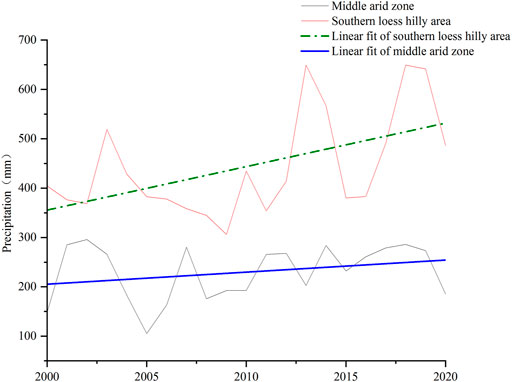
FIGURE 5. Variation in precipitation in the middle arid zone and southern Loess hilly area along with the linear fit.
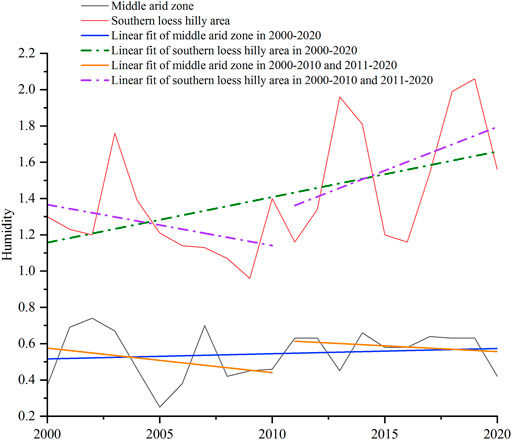
FIGURE 6. Variation in humidity in the middle arid zone and southern Loess hilly area along with the linear fit plots for 2000–2020, 2000–2010, and 2011–2020.
The Effect of the GGP on Land-Use Changes and Soil C Accumulation
Land-use change has a major impact on the global carbon cycle by altering soil C accumulation rates and turnover, soil erosion, and vegetation biomass (Post and Kwon, 2000; Fang et al., 2001; Li et al., 2012). A systematic evaluation of the effects of LUCC on SOC storage could enable us to better manage soil carbon pools in arid inland regions (Li et al., 2022). From 2000 to 2018, under the influence of the GGP, 347.62 km2 of cultivated land was converted into grasslands, increasing grassland soil carbon sequestration by 1.31. This result suggested that land cover changes induced by the GGP potentially led to carbon sequestration in the steppe. However, on the other hand, a stark reduction of 399.48 km2 grasslands was observed in Zhongning, Shapotou, Hongsibao, and Tongxin, and there are three possible reasons for the decrease in grasslands. First, the population of the four counties increased by 19.71%, 19.07%, 44.21%, and 3.63% during 2005–2019. The ecological capacity of the arid area was low, but the increasing population brought greater challenges to ecological construction. Second, driven by economic benefits, a large-scale industrial park construction was carried out, and grasslands were reclaimed to grow wolfberry and selenium sand melon. Third, shrubs and trees were planted on grasslands to increase the forest coverage rate, resulting in a substantial shrinkage of the grassland area. Hence, the GGP policy should be integrated with the population policy and economic reforms to be appropriately effective (Feng et al., 2005). In fact, grasslands decreased by 147.41 km2 from 2000–2018 in the middle arid zone and 10.69% of 1,379.00 km2 reduced during 1990–2000; therefore, the GGP is an effective measure to avoid excessive, rapid, and large-scale occupation of the grasslands in the arid region.
Limitations and Implications
Although we tried to select representative sample plots to estimate the SOC sequestration potential under grazing exclosure with relative precision, there were still some uncertainties. First, a bottom-up method was used to estimate the regional grassland carbon storage from the measured values of the sample sites, and the estimation accuracy was affected by the number of observed sample points (Lu et al., 2009.; Chang et al., 2011). In the future, the use of more site studies and longer time series measurements may reduce uncertainty. Second, in the Second National Soil Census, most soil profiles lack bulk density data, and the reference bulk density data in the literature were used to replace the missing data, which may have a certain impact on the estimation accuracy of organic carbon density. In addition, Conant and Paustian (2002) demonstrated a positive relationship between potential carbon sequestration and mean annual precipitation (MAP) on a global scale. (Likewise, Yang et al. 2008) concluded that soil organic carbon density increased significantly with the increase in annual precipitation in alpine grasslands. The precipitation in the study area has increased in the past 20 years (Figure 5), which has a certain impact on the soil's organic carbon content. In this study, we did not quantitatively calculate the impact of climate change on soil organic carbon. Therefore, the impact of the GGP on grassland organic carbon storage may be amplified.
The results showed that grazing exclosures have a positive soil C sequestration effect and are an important alternative to ecological restoration. Qiu et al. (2013) found that species diversity and C storage might decrease during the late stage of succession because of litter-layer accumulation, light and water resource competition, and accelerated decomposition rates. Therefore, further long-term fixed-point research is necessary to evaluate the long-term impact of grazing exclosure on grassland restoration. The remote-sensing techniques shown in this study can effectively monitor the effect of GGP on grassland C stock induced by land-cover changes. The grasslands increased by 95.55 km2 in the southern Loess hilly region due to the GGP, while forestland increased by 414.33 km2 and grasslands decreased by 147.41 km2 in the middle arid zone. This drastic contrast needs to be considered. In arid and semi-arid regions, water is the limiting factor for vegetation restoration. One of the major concerns of the GGP was its potential impact on water resources. According to Wang et al. (2011), compared with grasslands, forest vegetation is more likely to form a thicker dry layer due to its strong water consumption capacity. Chang et al. (2011) and Deng et al. (2014b) reported that grasslands have higher carbon sequestration rates than shrubs or forests in the Loess Plateau region. Cao et al. (2020) reported that abandoned lands afford greater soil organic carbon storage than afforested lands in arid and semiarid lands of the Loess Plateau. In the middle arid zone with an average rainfall of 200 mm, it is difficult for trees to survive without irrigation. Hence, planting a large number of trees is not conducive to ecological restoration and C accumulation. The follow-up policy of the GGP should be implemented and regulated according to local conditions.
Conclusion
Our research shows that the temperate steppe exhibited high carbon sequestration potential. Grassland degradation could be well-controlled, and ecological service functions such as carbon storage can be restored through ecological engineering, such as GGP and GE. Grazing exclosure increased grassland organic carbon density and soil carbon storage. GGP can effectively curb grassland occupation and promote the optimization of land-use patterns in the study area. However, the land-use conversion from cultivated land and grassland to forestland, which leads to grassland decrease and is not conducive to ecological restoration and C accumulation, especially in the middle arid zone of the study area, should be exercised with extreme caution. The follow-up policies of the GGP and GE should be implemented and improved according to local conditions. The study can provide a theoretical basis for the carbon sink management of grassland ecosystems and degraded grassland ecological restoration.
Data Availability Statement
The original contributions presented in the study are included in the article/Supplementary Material; further inquiries can be directed to the corresponding author.
Author Contributions
JD: conceptualization, writing, editing, and supervision. WM: conceptualization, methodology, validation, and critically reviewed the manuscript, as did QW. AL and KH: software, formal analysis, and data collection. XW and HX: data collection and supervision. All authors have read and agreed on the final contents of the manuscript. The authors read and approved the final manuscript.
Funding
This study was supported by the National Natural Science Foundation of China (42061037).
Conflict of Interest
The authors declare that the research was conducted in the absence of any commercial or financial relationships that could be construed as a potential conflict of interest.
Publisher’s Note
All claims expressed in this article are solely those of the authors and do not necessarily represent those of their affiliated organizations, or those of the publisher, the editors, and the reviewers. Any product that may be evaluated in this article, or claim that may be made by its manufacturer, is not guaranteed or endorsed by the publisher.
References
Cao, J., Wei, C., Adamowski, J. F., Zhou, J., Liu, C., Zhu, G., et al. (2020). Could Arid and Semi-arid Abandoned Lands Prove Ecologically or Economically Valuable if They Afford Greater Soil Organic Carbon Storage Than Afforested Lands in China's Loess Plateau? Land Use Policy 99, 105027. doi:10.1016/j.landusepol.2020.105027
Chai, Q., Ma, Z., Chang, X., Wu, G., Zheng, J., Li, Z., et al. (2019). Optimizing Management to Conserve Plant Diversity and Soil Carbon Stock of Semi-arid Grasslands on the Loess Plateau. Catena 172, 781–788. doi:10.1016/j.catena.2018.09.034
Chang, R., Fu, B., Liu, G., and Liu, S. (2011). Soil Carbon Sequestration Potential for "Grain for Green" Project in Loess Plateau, China. Environ. Manag. 48, 1158–1172. doi:10.1007/s00267-011-9682-8
Conant, R. T., Paustian, K., and Elliott, E. T. (2001). Grassland Management and Conversion into Grassland: Effects on Soil Carbon. Ecol. Appl. 11, 343–355. doi:10.1890/1051-0761(2001)011[0343:gmacig]2.0.co;2
Conant, R. T., and Paustian, K. (2002). Potential Soil Carbon Sequestration in Overgrazed Grassland Ecosystems. Glob. Biogeochem. Cycles 16 (4), 90–91. doi:10.1029/2001gb001661
Dai, L., Fu, R., Guo, X., Du, Y., Lin, L., Zhang, F., et al. (2021). Long-term Grazing Exclusion Greatly Improve Carbon and Nitrogen Store in an Alpine Meadow on the Northern Qinghai-Tibet Plateau. Catena 197, 104955. doi:10.1016/j.catena.2020.104955
Deng, L., Liu, G.-b., and Shangguan, Z.-p. (2014). Land-use Conversion and Changing Soil Carbon Stocks in China's 'Grain-for-Green' Program: a Synthesis. Glob. Change Biol. 20, 3544–3556. doi:10.1111/gcb.12508
Deng, L., Liu, S., Kim, D. G., Peng, C., Sweeney, S., and Shangguan, Z. (2017a). Past and Future Carbon Sequestration Benefits of China’s Grain for Green Program. Glob. Environ. Change-Human Policy Dimensions 47, 13e20. doi:10.1016/j.gloenvcha.2017.09.006
Deng, L., Shangguan, Z.-p., and Sweeney, S. (2014b). "Grain for Green" Driven Land Use Change and Carbon Sequestration on the Loess Plateau, China. Sci. Rep. 4, 7039. doi:10.1038/srep07039
Deng, L., Shangguan, Z.-P., Wu, G.-L., and Chang, X.-F. (2017b). Effects of Grazing Exclusion on Carbon Sequestration in China's Grassland. Earth-Science Rev. 173, 84–95. doi:10.1016/j.earscirev.2017.08.008
Deng, L., Shangguang, Z., and Li, R. (2012). Effects of the Grain-For-Green Programme on Soil Erosion in China. Int. J.Sediment Res. 27, 120–127. doi:10.1016/S1001-6279(12)60021-3
Ding, C. (2003). Land Policy Reform in China: Assessment and Prospects. Land Use Policy 20, 109–120. doi:10.1016/s0264-8377(02)00073-x
Fang, J., Chen, A., Peng, C., Zhao, S., and Ci, L. (2001). Changes in Forest Biomass Carbon Storage in China between 1949 and 1998. Science 292, 2320–2322. doi:10.1126/science.1058629
Feng, Z., Yang, Y., Zhang, Y., Zhang, P., and Li, Y. (2005). Grain-for-green Policy and its Impacts on Grain Supply in West China. Land Use Policy 22, 301–312. doi:10.1016/j.landusepol.2004.05.004
Follett, R. F., and Reed, D. A. (2010). Soil Carbon Sequestration in Grazing Lands: Societal Benefits and Policy Implications. Rangel. Ecol. Manag. 63, 4–15. doi:10.2111/08-225.1
Fu, B., Liu, Y., Lü, Y., He, C., Zeng, Y., and Wu, B. (2011). Assessing the Soil Erosion Control Service of Ecosystems Change in the Loess Plateau of China. Ecol. Complex. 8 (4), 284–293. doi:10.1016/j.ecocom.2011.07.003
Hu, Z., Li, S., Guo, Q., Niu, S., He, N., Li, L., et al. (2016). A Synthesis of the Effect of Grazing Exclusion on Carbon Dynamics in Grasslands in China. Glob. Change Biol. 22, 1385–1393. doi:10.1111/gcb.13133
Hua, J., Zhao, S., Zhang, Y., and Ma, S. (2009). Distribution Characteristics of Soil Labile Organic Carbon of Different Grassland Communities in Yunwu Mountain. Acta Agrestia Sin. 17 (3), 315–320. (in Chinese).
Li, D., Niu, S., and Luo, Y. (2012). Global Patterns of the Dynamics of Soil Carbon and Nitrogen Stocks Following Afforestation: a Meta-Analysis. New Phytol. 195, 172–181. doi:10.1111/j.1469-8137.2012.04150.x
Li, W., Liu, C., Wang, W., Zhou, H., Xue, Y., Xu, J., et al. (2021). Effects of Different Grazing Disturbances on the Plant Diversity and Ecological Functions of Alpine Grassland Ecosystem on the Qinghai-Tibetan Plateau. Front. Plant Sci. 12, 765070. doi:10.3389/fpls.2021.765070
Li, X., Wang, Z., Wang, D., Wang, L., Pan, D., Li, J., et al. (2019). Livestock Grazing Impacts on Plateau Pika (Ochotona Curzoniae) Vary by Species Identity. Agric. Ecosyst. Environ. 275, 23–31. doi:10.1016/j.agee.2019.01.007
Li, Y., Liu, W., Feng, Q., Zhu, M., Yang, L., and Zhang, J. (2022). Effects of Land Use and Land Cover Change on Soil Organic Carbon Storage in the Hexi Regions, Northwest China. J. Environ. Manag. 312–114911. doi:10.1016/j.jenvman.2022.114911
Liu, J., and Diamond, J. (2008). Science and Government. Revolutionizing China's Environmental Protection. Science 319 (4), 37–38. doi:10.1126/science.1150416
Lu, F., Wang, X., Han, B., Ouyang, Z., Duan, X., Zheng, H., et al. (2009). Soil Carbon Sequestrations by Nitrogen Fertilizer Application, Straw Return and No-Tillage in China's Cropland. Glob. Change Biol. 15, 281–305. doi:10.1111/j.1365-2486.2008.01743.x
Luo, R., Fan, J., Wang, W., Luo, J., Kuzyakov, Y., He, J.-S., et al. (2019). Nitrogen and Phosphorus Enrichment Accelerates Soil Organic Carbon Loss in Alpine Grassland on the Qinghai-Tibetan Plateau. Sci. Total Environ. 650, 303–312. doi:10.1016/j.scitotenv.2018.09.038
Pei, S., Fu, H., and Wan, C. (2008). Changes in Soil Properties and Vegetation Following Exclosure and Grazing in Degraded Alxa Desert Steppe of Inner Mongolia, China. Agric. Ecosyst. Environ. 124, 33–39. doi:10.1016/j.agee.2007.08.008
Persson, M., Moberg, J., Ostwald, M., and Xu, J. (2013). The Chinese Grain for Green Programme: Assessing the Carbon Sequestered via Land Reform. J. Environ. Manage 126, 142–146. doi:10.1016/j.jenvman.2013.02.045
Post, W. M., and Kwon, K. C. (2000). Soil Carbon Sequestration and Land-Use Change: Processes and Potential. Glob. Change Biol. 6, 317–327. doi:10.1046/j.1365-2486.2000.00308.x
Qiu, L., Wei, X., Zhang, X., and Cheng, J. (2013). Ecosystem Carbon and Nitrogen Accumulation after Grazing Exclusion in Semiarid Grassland. PLoS One 8, e55433. doi:10.1371/journal.pone.0055433
Scharlemann, J. P., Tanner, E. V., Hiederer, R., and Kapos, V. (2014). Global Soil Carbon: Understanding and Managing the Largest Terrestrial Carbon Pool. Carbon Manag. 5 (1), 81–91. doi:10.4155/cmt.13.77
Schimel, D. S., Braswell, B. H., Holland, E. A., Mckeown, R., Ojima, D. S., Painter, T. H., et al. (1994). Climatic, Edaphic, and Biotic Controls over Storage and Turnover of Carbon in Soils. Glob. Biogeochem. Cycles 8 (3), 279–293. doi:10.1029/94gb00993
Smith, S. W., Johnson, D., Quin, S. L. O., Munro, K., Pakeman, R. J., van der Wal, R., et al. (2015). Combination of Herbivore Removal and Nitrogen Deposition Increases Upland Carbon Storage. Glob. Change Biol. 21, 3036–3048. doi:10.1111/gcb.12902
Song, X., Peng, C., Zhou, G., Jiang, H., and Wang, W. (2014). Chinese Grain for Green Program Led to Highly Increased Soil Organic Carbon Levels: A Meta-Analysis. Sci. Rep. 4, 4460. doi:10.1038/srep04460
Su, Y. (2006). Soil Carbon and Nitrogen Sequestration Following Cropland to Forage Grassland Conversion in the Marginal Land in the Middle of Heihe River Basin‚ Northwest China. Environ. Sci. 27 (7), 1312–1318. (in Chinese).
Sun, H. (2003). An Approach to the Development Direction of Farming and Animal Husbandry in North West Area of China. Acta Prataculturae Sin. 2003(4), 1–6. (in Chinese).
Tai, X., Epstein, H., and Li, B. (2021). Effects of Grazing Exclusion on Spring and Autumn Pastures in Arid Region of China: Insights from Field Surveys and Landsat Images. Agric. Ecosyst. Environ. 310, 107302. doi:10.1016/j.agee.2021.107302
Tang, X., Zhao, X., Bai, Y., Tang, Z., Wang, W., Zhao, Y., et al. (2018). Carbon Pools in China's Terrestrial Ecosystems: New Estimates Based on an Intensive Field Survey. Proc. Natl. Acad. Sci. U.S.A. 115, 4021–4026. doi:10.1073/pnas.1700291115
Tian, Z., Wu, X., Dai, E., and Zhao, D. (2016). SOC Storage and Potential of Grasslands from 2000 to 2012 in Central and Eastern Inner Mongolia, China. J. Arid. Land 8 (3), 364–374. doi:10.1007/s40333-016-0041-8
Wang, D., Wu, G.-L., Zhu, Y.-J., and Shi, Z.-H. (2014). Grazing Exclusion Effects on above- and Below-Ground C and N Pools of Typical Grassland on the Loess Plateau (China). Catena 123, 113–120. doi:10.1016/j.catena.2014.07.018
Wang, G., Innes, J. L., Lei, J., Dai, S., and Wu, S. W. (2007). China's Forestry Reforms. Science 318, 1556–1557. doi:10.1126/science.1147247
Wang, K., Deng, L., Ren, Z., Li, J., and Shangguan, Z. (2016). Grazing Exclusion Significantly Improves Grassland Ecosystem C and N Pools in a Desert Steppe of Northwest China. Catena 137, 441–448. doi:10.1016/j.catena.2015.10.018
Wang, M., Yang, W., Wu, N., Wu, Y., Lafleur, P., and Lu, T. (2019). Patterns and Drivers of Soil Carbon Stock in Southern China’s Grasslands. Agric. For. Meteorology, 2019, 276–277. doi:10.1016/j.agrformet.2019.10763
Wang, Y., Fu, B., Lü, Y., Song, C., and Luan, Y. (2010). Local-Scale Spatial Variability of Soil Organic Carbon and its Stock in the Hilly Area of the Loess Plateau, China. Quat. Res. 73, 70–76. doi:10.1016/j.yqres.2008.11.006
Wang, Y., Shao, M. a., Zhu, Y., and Liu, Z. (2011). Impacts of Land Use and Plant Characteristics on Dried Soil Layers in Different Climatic Regions on the Loess Plateau of China. Agric. For. Meteorology 151, 437–448. doi:10.1016/j.agrformet.2010.11.016
Xiong, D., Shi, P., Zhang, X., and Zou, C. B. (2016). Effects of Grazing Exclusion on Carbon Sequestration and Plant Diversity in Grasslands of China-a Meta-Analysis. Ecol. Eng. 94, 647–655. doi:10.1016/j.ecoleng.2016.06.124
Xu, L., Yu, G., and He, N. (2018). Changes of Soil Organic Carbon Storage in Chinese Terrestrial Ecosystems from the 1980s to the 2010s. Acta Geogr. Sin. 73 (11), 2150–2167. (in Chinese).
Yang, Y., Fang, J., Tang, Y., Ji, C., Zheng, C., He, J., et al. (2008). Storage, Patterns and Controls of Soil Organic Carbon in the Tibetan Grasslands. Glob. Change Biol. 14 (7), 1592–1599. doi:10.1111/j.1365-2486.2008.01591.x
Yu, L., Chen, Y., Sun, W., and Huang, Y. (2019a). Effects of Grazing Exclusion on Soil Carbon Dynamics in Alpine Grasslands of the Tibetan Plateau. Geoderma 353, 133–143. doi:10.1016/j.geoderma.2019.06.036
Yu, S., Tao, L., and Xu, D. (2019b). Effects of Enclosure on the Soil Organic Carbon and its Active Components in Desert Steppe Grassland. Acta Prataculturae Sin. 28 (2), 190–196. (in Chinese).
Zhang, J., Feng, Z., and Jiang, L. (2011). Progress on Studies of Land Use/land Cover Classification Systems. Resour. Sci. 33 (6), 1195–1203. (in Chinese).
Zhang, L., Zhou, G., Ji, Y., and Bai, Y. (2016). Spatiotemporal Dynamic Simulation of Grassland Carbon Storage in China. Sci. China Earth Sci. 59, 1946–1958. (in Chinese). doi:10.1007/s11430-015-5599-4
Keywords: carbon sequestration, grain for green program, grazing exclosure, grasslands, Loess Plateau
Citation: Ding J, Mi W, Wen Q, Luo A, Hou K, Wu X and Xu H (2022) Effects of the Main Ecological Restoration Projects on Grassland Carbon Sequestration in Ningxia on the Loess Plateau. Front. Environ. Sci. 10:908236. doi: 10.3389/fenvs.2022.908236
Received: 30 March 2022; Accepted: 09 May 2022;
Published: 15 June 2022.
Edited by:
Jianjun Cao, Northwest Normal University, ChinaReviewed by:
Meng Zhu, Northwest Institute of Eco-Environment and Resources (CAS), ChinaChunhui Zhang, Qinghai University, China
Copyright © 2022 Ding, Mi, Wen, Luo, Hou, Wu and Xu. This is an open-access article distributed under the terms of the Creative Commons Attribution License (CC BY). The use, distribution or reproduction in other forums is permitted, provided the original author(s) and the copyright owner(s) are credited and that the original publication in this journal is cited, in accordance with accepted academic practice. No use, distribution or reproduction is permitted which does not comply with these terms.
*Correspondence: Wenbao Mi, bWl3YkBueHUuZWR1LmNu
 Jinmei Ding
Jinmei Ding Wenbao Mi1,2*
Wenbao Mi1,2* Qi Wen
Qi Wen